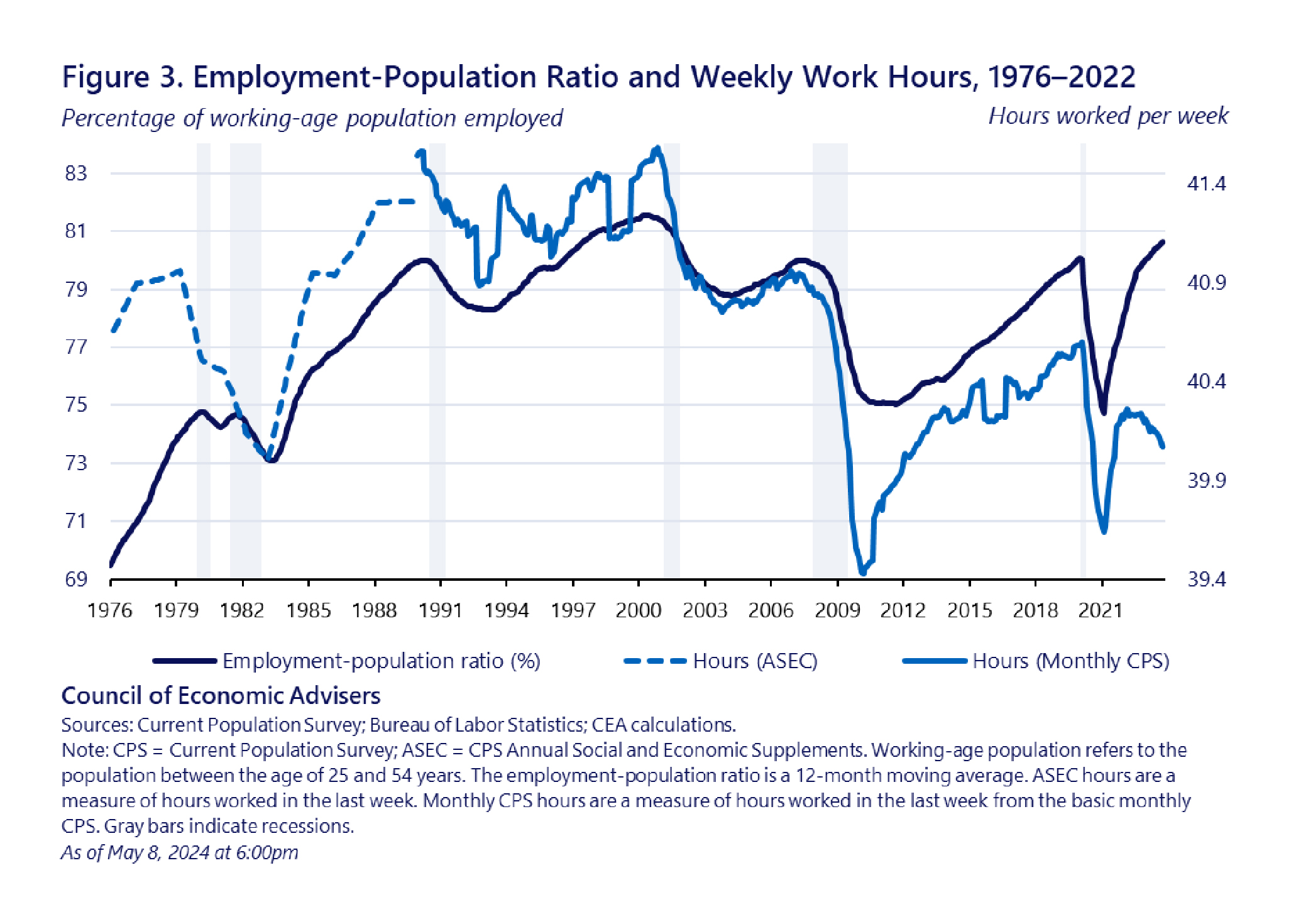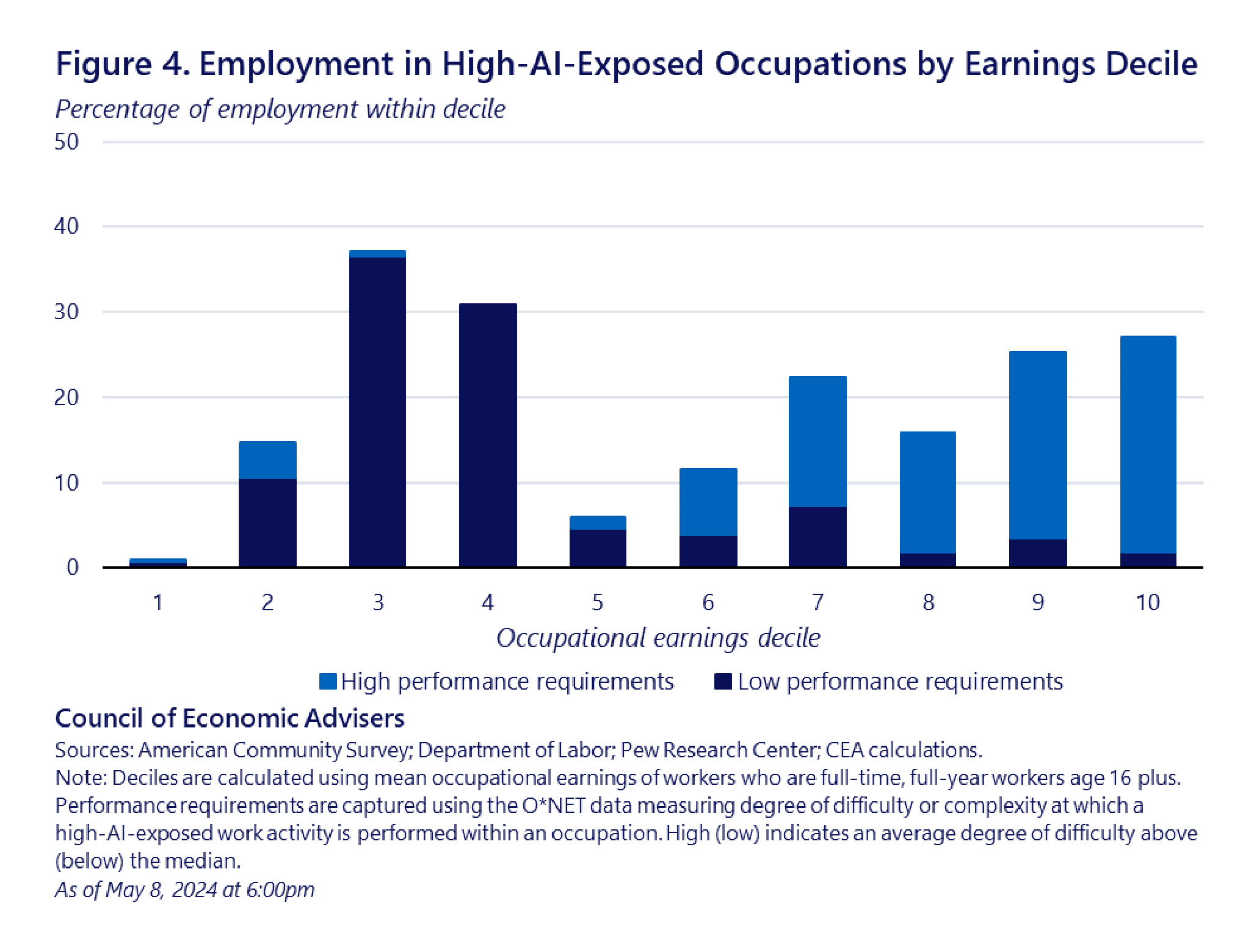The CEA recently released a report which, while early days, identifies current and potential differential impacts of AI by income levels, education, job skills, gender, and urban vs rural locations.
The CEDA starts with a big caveat - it thinks that, as with earlier technology waves AI will be a positive overall for the US labour market:
Economists and others have predicted for centuries that technological change might lead to widespread technological unemployment or drastically reduced hours of work. Yet, as [the figure below] demonstrates, measures of employment such as the working-age employment-population ratio and average hours of work show little evidence of decline in recent decades. In fact, the employment rate remains close to long-term highs, matched only by a period in the late 1990s in which technological change and productivity growth was also rapid, commonly associated with the previous general-purpose technologies of the personal computer and internet adoption.
The Luddites foresaw that new textile machinery such as the power loom would negatively impact wages and labor standards among skilled textile workers, and they destroyed that machinery in response. General-purpose technologies are distinguished not only by the breadth of their potential applications, but by the way in which they create new opportunities for improvements in other sectors for example, underpinning the adoption of technologies like the power loom was the steam engine, a general-purpose technology that could be adapted to many different purposes throughout the economy. Even as some use cases like the power loom negatively impacted some skilled craftspeople, a major effect of the steam engine was to draw farm workers into factory labor, and this likely increased the overall demand for skill in the economy.
CEA’s AI-related job performance requirements use information from a [US Government labour database] about the degree of complexity or difficulty to which each work activity must be performed in order to perform one’s overall job. The underlying assumption guiding this measure is that complexity and difficulty are closely related to costs of adoption. If it is more costly and difficult for AI to fully substitute for human performance of an activity, then using AI to complement performance of that activity may be more feasible or cost effective than using AI to fully automate the activity.
Some regions with among the highest AI exposure—such as portions of Silicon Valley—have among the lowest rates of AI-related performance requirements in the country. This suggests that the places that may be most at risk of substantial AI-related displacement could be quite different from the places where AI is simply being widely used.
Employment growth of AI-exposed occupations with low performance requirements has been consistently slower than that of occupations with high performance requirements for nearly two decades, as well as of occupations which are not highly exposed to AI. In early periods, employment growth across these three groups was largely in parallel. They also responded similarly during the Great Recession and subsequent recovery.
However, in more recent years, there has been some divergence in growth patterns across the three groups. The gap in employment group between the high- and low-performance requirement groups increased substantially in the latter portion of the last decade. And, employment in the non-exposed group declined more strongly and recovered more quickly from the pandemic recession period, potentially reflecting differences in the working environments of AI-exposed and less-exposed employment. Employment growth between 2021 and 2022 was again largely in parallel, although this finding is challenging to interpret in light of the ongoing pandemic recovery at that time.
Regardless of their initial occupations, workers are increasingly likely to have transitioned to an AI-exposed job with high AI-related performance requirements, and decreasingly likely to have transitioned to an AI-exposed job with low AI-related performance requirements. Workers who start out in a high AI-exposure, high performance-requirements job are increasingly likely to remain in the same occupation. Conversely, workers who are employed in low performance requirement jobs are increasingly likely to change occupations.
[T]he complexity and difficulty of many AI-exposed occupations with low performance requirements have changed little since 2007, and this is reflected in the near zero change for the median worker in that category. On the other hand, the median worker in an AI-exposed job with high AI-related performance requirements has seen those requirements increase over time.
The potential benefits from AI are substantial. Many workers are likely to benefit from use of the technology, and productivity gains could substantially improve economic wellbeing overall. Nonetheless, a subset of workers may be at risk of displacement, declining earnings, or other negative economic outcomes in response to the technology’s adoption. Identifying such vulnerable workers in advance as CEA’s measure attempts to do may help to ensure that policies designed to help them transition or otherwise adapt in response to AI are efficiently targeted and executed.
[W]e need technology that expands human capacities rather than supplanting the place of human beings in the productive structure of the economy.
Read more: Potential Labor Market Impacts of Artificial Intelligence: An Empirical Analysis



